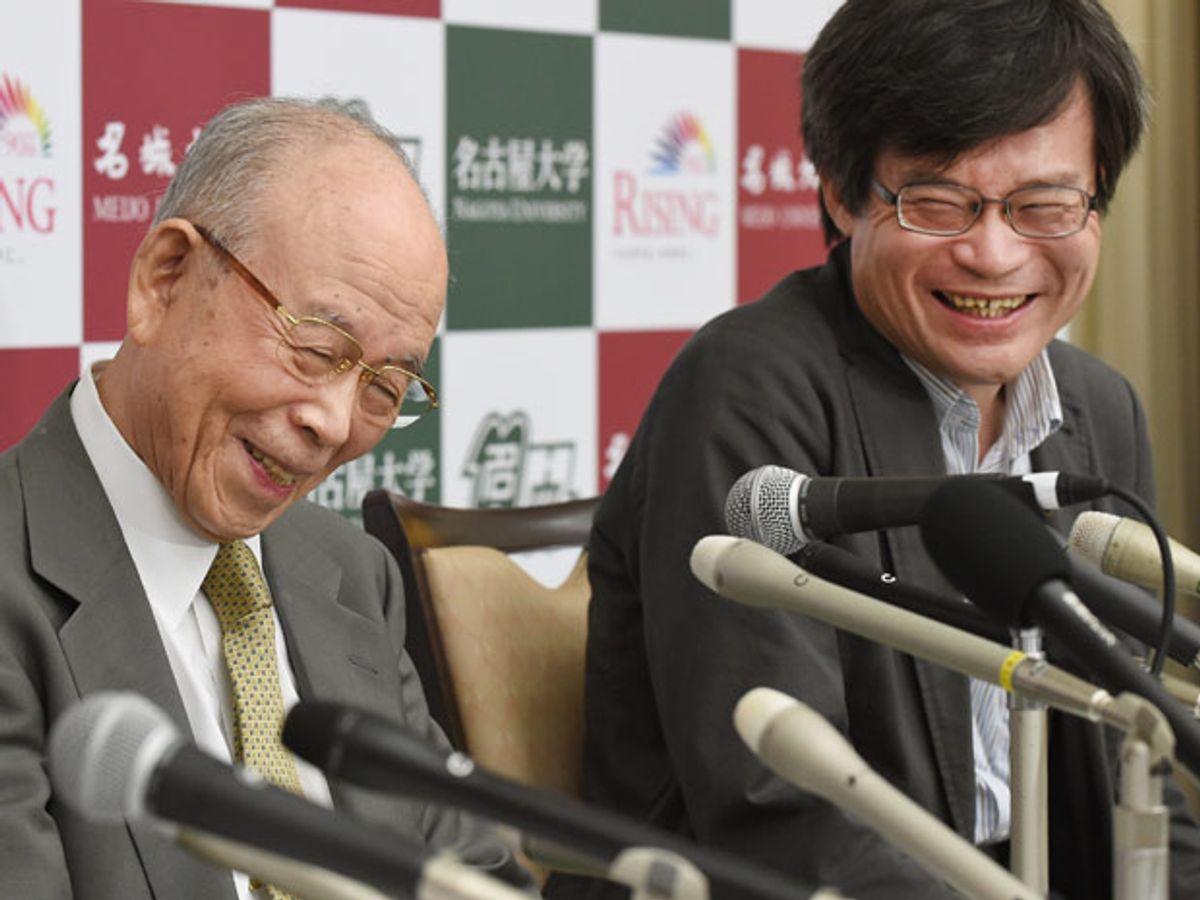The story of science and technology today is the story of many hands. But try as we might, it’s hard to get away from the hero narrative. It’s still easy for us to get swept up by the tales of lone inventors, who battle the powers-that-be and fight against all odds to prove themselves right.
The stories that we tell about the development of the blue LED are no exception. The hero has long been Shuji Nakamura, one of this year’s winners of the Nobel Prize in Physics. Nakamura, working “virtually alone” for a small, geographically remote company called Nichia Chemical Industries, was responsible for developing manufacturing processes that brought the first truly bright blue LEDs to market. He’s since become the face of the device.
The thing is, it’s hard to say if any of this would have happened without the efforts of a number of others, in particular his two fellow awardees, Isamu Akasaki and Akasaki’s former student, Hiroshi Amano. “The work of Nakamura could not have been done without the work of Akasaki,” says Christophe Lécuyer, a professor of the history of science and technology at the Université Pierre et Marie Curie. As Lécuyer and his co-author Takahiro Ueyama outline in this excellent history of the development of the blue LED, Akasaki’s story was at least as heroic as Nakamura’s.
It was Akasaki who picked up work on gallium nitride, the material used to make the blue LEDs, after RCA abandoned its efforts in the early 1970s. At the time, the basics of semiconductor processing still had to be sorted out. It wasn’t clear how to grow large, clean crystals or how to “dope” the material so that it could be made into a p-type semiconductor, a semiconductor with an excess of holes. That’s what was needed in order to create the “p” in the p-n junction light-emitting diode, a better approach to making bright light than the metal insulator semiconductor devices made at RCA.
Akasaki spent more than 15 years trying to tame gallium nitride. He began his work at a research arm of Matsushita Electric Industrial (now Panasonic), and made little progress in the first five years. In 1978, he saw microscope images showing that there were high quality microcrystals inside the gallium nitride crystals his team had grown; they were physically possible.
Somewhere along the way “he had become obsessed with gallium nitride,” Lécuyer and Ueyama write. Akasaki was convinced he could make good crystals and workable p-n junctions from gallium nitride. But few shared his faith. When Akasaki moved from industry to academia in 1981, Lécuyer and Ueyama say, he had to finance his work on gallium nitride by siphoning money from grants for research on other compound semiconductors: “no Japanese governmental agency wanted to support research on such a hopeless material.”
It was at Akasaki’s lab at Nagoya University that he and doctoral student Hiroshi Amano developed a way to make high-quality gallium nitride. They used a different method to grow the crystals that relied on metal-organic gases instead of hydrogen-based ones. This let them introduce a “buffer” layer of aluminum nitride on top of the sapphire substrate before growing the gallium nitride. The buffer layer better matched the crystal structure, resulting in fewer flaws.
It was this work, published in 1986, that attracted the attention of others, including Shuji Nakamura. Akasaki’s lab then found a way to p-dope the material, by adding magnesium atoms and zapping the crystals with electron beams. In 1989, the team announced the first p-n junction LED, nearly 100 times brighter than what came before. Nakamura’s group followed with a lower-cost doping method (low-temperature heating) and several other innovations that boosted quality and brightness. Although Nakamura’s company was the first to begin selling blue p-n junction LEDs, they soon faced competition by a company working with Akasaki: Toyoda Gosei.
Nichia became “embroiled in a bitter patent war” with Toyoda Gosei and launched “an energetic public relations campaign” to brand Nakamura as the father of the blue LED, Lécuyer and Ueyama write.
Ueyama, a professor of policy management at Keio University, tells me the lone inventor image caught on, not just in the West but in Japan as well, because it was a romantic one. “Even now, the public does not know the names of Akasaki and Amano,” Ueyama says. Nakamura’s story was a “Cinderella-like success story,” the heroic tale of an intrepid engineer at a tiny company competing directly against the academic elite. For Japanese workers who had selflessly devoted themselves to their companies, Nakamura’s reputation was further boosted by his “revolt” — a lawsuit filed against Nichia Chemical for a fair share of the profits.
Lécuyer and Ueyama’s work shows how much the popular telling of a discovery can be shaped over the years, by companies and the press and our own inclinations toward tales of heroism. But the story of gallium nitride, like many others, is the story of a community. The Royal Swedish Academy of Sciences did its best to recognize that.
Rachel Courtland, an unabashed astronomy aficionado, is a former senior associate editor at Spectrum. She now works in the editorial department at Nature. At Spectrum, she wrote about a variety of engineering efforts, including the quest for energy-producing fusion at the National Ignition Facility and the hunt for dark matter using an ultraquiet radio receiver. In 2014, she received a Neal Award for her feature on shrinking transistors and how the semiconductor industry talks about the challenge.



